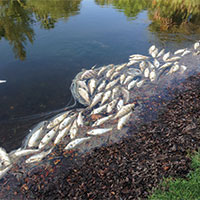 Massive fish kill still a mystery at The Shores
Massive fish kill still a mystery at The Shores
STORY
A massive fish kill in the narrow lakes that meander through the elegant Shores community just north of John’s Island remains something of a mystery six weeks after it was first reported. Pesticides are believed to blame, but water test results ordered by the Department of Agriculture and Consumer Affairs haven’t come back yet so the specific poison has not been identified.
Also unknown is who applied the pesticide, if pesticides were indeed the culprit, and if any laws were broken in the process. Elliott Merrill is community manager for The Shores but no one from the company has provided any information about what happened, despite a number of phone and e-mail inquiries.
“We obtained water samples on June 1 and again on the June 6 [after another kill was reported], and sent them off, but we are still waiting on the test results,” said Florida Department of Agriculture press secretary Erin Gillespie. “We will be looking to see if laws were broken.”
The Shores has a sprawling interconnected network of narrow lakes and the kill extended throughout the park-like community, according to eyewitnesses.
“There were dead fish everywhere,” said Wyatt Guy, who reported the kill to the Florida Fish and Wildlife Conservation Commission. “It looked like someone had been spraying along the edge of the lakes. It was heartbreaking to see all those fish killed. I have been dealing with this since I was a little kid growing up in Margate. I would watch them come down the canal spraying the banks and then see all the dead fish float up.
“I would report it to the city and they would say that the pesticides don’t kill fish, and maybe they don’t, directly, but they pull the oxygen out of the water and the fish can’t survive.”
Josh Nezbit confirms the kill was widespread. “The worst of it was at the end of the lake right by the construction entrance, but there were dead fish in all the lakes. It smelled really bad. It is a real shame what happened.”
Nezbit and Guy both work for a swimming pool maintenance and repair business and are in the subdivision regularly taking care of residents’ pools.
They say most of the dead fish were snook, 20 to 30 inches long. They also saw ladyfish, sheepshead and tarpon.
“Apparently the lakes used to be connected to the lagoon; residents have told me they closed the connection at some point, but I don’t really know,” said Nezbit. “I think it was a Tuesday when we saw the fish and when I came back the following Tuesday, everything was cleaned up.”
Guy called Fish and Wildlife’s fish kill hotline at 9:43 am on Tuesday, April 30. Fish and Wildlife responded and took water samples. Because pesticides were the apparent cause of the kill, the agency then handed the samples and the problem off to the Department of Agriculture, which “is the state licensing agency in Florida for pesticide applicators who must be licensed to use EPA-registered, restricted-use pesticides ... [and] is responsible for enforcing all pesticide regulations and laws, both state and federal,” according to the department’s website.
Gillespie said she is not sure how long it will take for the water sample test results to come back, but promised the department will investigate the incident once it knows what chemicals were involved.
Elliott Merrill manages more than 70 communities in Indian River, Brevard and St. Lucie counties, including many on the barrier island. The Shores website lists the company as community manager and provides contact information for Holly Leide, assistant to Shores Community Manager Lee Rech.
Leide told Vero Beach 32963 she could not comment on the fish kill and referred a reporter to Rech, who has not responded to several messages.
Because the company has not been forthcoming, it is not known if Elliott Merrill personnel sprayed the deadly chemicals, if Elliott Merrill hired a pesticide contractor who over applied the chemicals, or if something else occurred in the community Elliott Merrill manages.
Pesticide contamination of U.S. waters is a major environmental problem and may be the next big issue in trying to solve the woes of the Indian River Lagoon.
“In recent studies of major rivers and streams, one or more pesticides were detected more than 90 percent of the time in water, in more than 80 percent of fish sampled, and in 33 percent of major aquifers,” according to U.S. Fish and Wildlife Service.
Pesticides are one of the top “causes of impairment for streams included on States’ Clean Water Act section 303(d) lists of impaired waters and ... have also been identified as a potential cause of amphibian declines and deformities.”
Pesticides – a term that encompasses herbicides such as atrazine – also damage seagrass, possibly contributing to loss of more than 47,000 acres of underwater meadows in the lagoon in 2011 and 2012.
“The impact of the herbicide atrazine on growth and photosynthesis of seagrass seedlings,” a study published in August 2011 issue of Marine Pollution Bulletin, found the weed killer, often used along the margins of lakes and ponds, interferes with seagrass seedling photosynthesis and growth.
The section of the lagoon adjacent to The Shores was one of the hardest hit areas in the seagrass die-off and is now barren.








